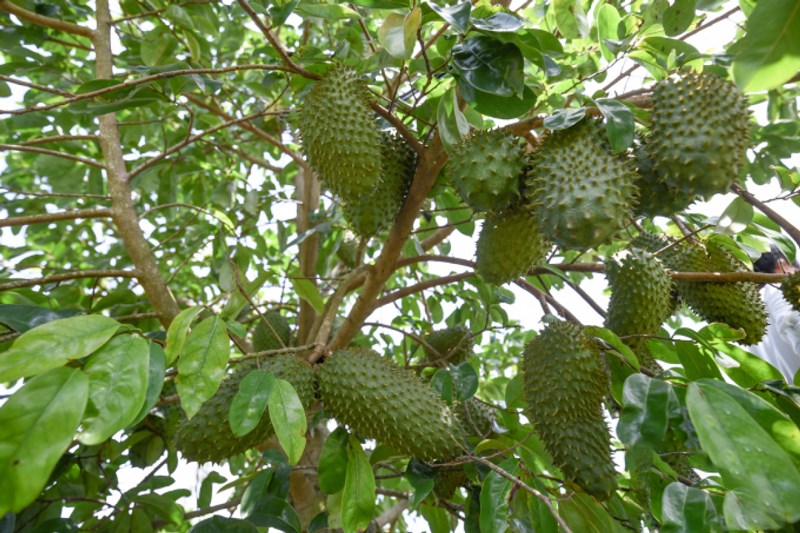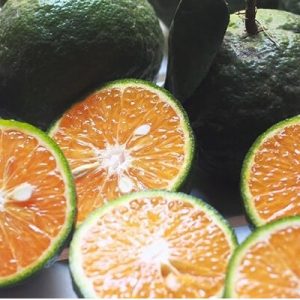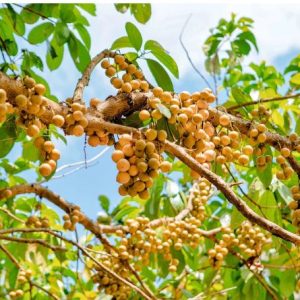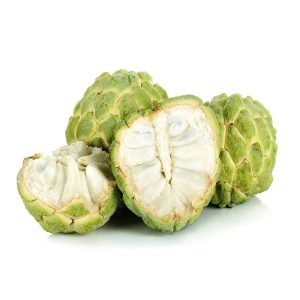Their flesh is juicy, acidic, whitish and aromatic. The fruits are dark green and prickly. They are ovoid and can be up to 30 centimetres (12 in) long, with a moderately firm texture.


With an aroma similar to pineapple, the flavor of the fruit has been described as a combination of strawberries and apple with sour citrus flavor notes, contrasting with an underlying thick creamy texture reminiscent of banana.
Annona muricata is a small, upright, evergreen tree that can grow to about 30 feet (9.1 m) tall.
Its young branches are hairy. Leaves are oblong to oval, 8 centimetres (3.1 in) to 16 centimetres (6.3 in) long and 3 centimetres (1.2 in) to 7 centimetres (2.8 in) wide. They are a glossy dark green with no hairs above, and paler and minutely hairy to no hairs below. The leaf stalks are 4 millimetres (0.16 in) to 13 millimetres (0.51 in) long and without hairs.
Flower stalks (peduncles) are 2 millimetres (0.079 in) to 5 millimetres (0.20 in) long and woody. They appear opposite from the leaves or as an extra from near the leaf stalk, each with one or two flowers, occasionally a third. Stalks for the individual flowers (pedicels) are stout and woody, minutely hairy to hairless and 15 millimetres (0.59 in) to 20 millimetres (0.79 in) with small bractlets nearer to the base which are densely hairy.
The petals are thick and yellowish. Outer petals meet at the edges without overlapping and are broadly ovate, 2.8 centimetres (1.1 in) to 3.3 centimetres (1.3 in) by 2.1 centimetres (0.83 in) to 2.5 centimetres (0.98 in), tapering to a point with a heart shaped base. They are evenly thick, and are covered with long, slender, soft hairs externally and matted finely with soft hairs within. Inner petals are oval shaped and overlap.
They measure roughly 2.5 centimetres (0.98 in) to 2.8 centimetres (1.1 in) by 2 centimetres (0.79 in), and are sharply angled and tapering at the base. Margins are comparatively thin, with fine matted soft hairs on both sides.
The receptacle is conical and hairy. The stamens are 4.5 millimetres (0.18 in) long and narrowly wedge-shaped. The connective-tip terminate abruptly and anther hollows are unequal. Sepals are quite thick and do not overlap. Carpels are linear and basally growing from one base. The ovaries are covered with dense reddish brown hairs, 1-ovuled, style short and stigma truncate. Its pollen is shed as permanent tetrads.
Besides fresh ginger, yellow tamarind, or green squash, the childhood fruit – soursop (mang cau in Vietnamese) must have become nostalgic memories in Southern Vietnamese people’s hearts. In recent years, despite being sometimes absent in the five-fruit tray every Tet holiday, this rewarding fruit is still close and connected to each Vietnamese family, and is adored by both adults and children.
Soursop is a fruit that has a delicious aroma and taste that is loved by both Vietnamese locals and foreigners. However, due to its rough skin, how to eat soursop can be a bit tricky to foreigners. You could try cutting the fruit correctly through the following way. First, rinse the fruit under clean running water for a few minutes to completely remove dirt, bacteria and preservatives. Then, peel off the outer skin with a knife or hand, and remove the stem and inner core. Finally, you can cut the fruit into small pieces. It can be eaten immediately or refrigerated for refreshment.
This plant grows very well in the land with lots of nutrients, good drainage, and warm sunshine all year round. In fact, soursop trees growing in Vietnam are plants imported from abroad. Its feature is suitable for hot humid tropical areas, with high humidity and not too cold. For this reason, they are popularly grown in the Southern Vietnamese provinces, especially the regions around the Mekong Delta of our country, or Central Highlands such as Dak Lak.
With a rich content of vitamins and minerals, soursop helps to improve overall health, while preventing aging, giving you a smooth, youthful skin. The fruit contains much more vitamin C compared to banana, grapes or pineapple. Therefore, soursop has a positive effect in improving the activity of the immune system and is also effective for blood tonic, improves digestion, strengthens resistance, lowers blood pressure and prevents cancer – a perfect supplement energy source for the body.
In addition, these nutrients also play a supporting role in the digestive process, increase the metabolism and convert fat into energy, helping the body to burn fat and excess sugar effectively. Hence, you can comfortably enjoy the soursopwithout worrying about storing excess fat since it is a fruit that helps you lose weight very quickly and effectively.
Soursops have a sweet taste and are quite delicious, so they are often used to make ice cream, candies or other foods and smoothie drinks. Additionally, its leaves can also be boiled and served like tea.

















Đánh giá
Chưa có đánh giá nào.